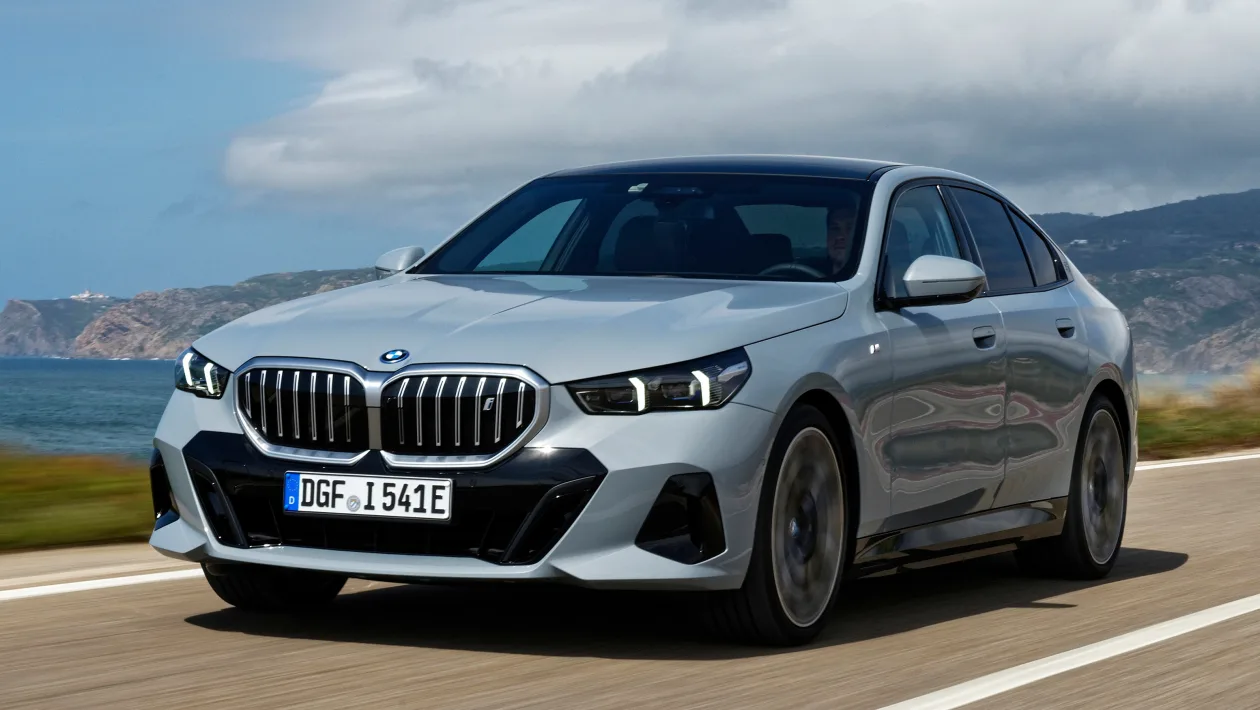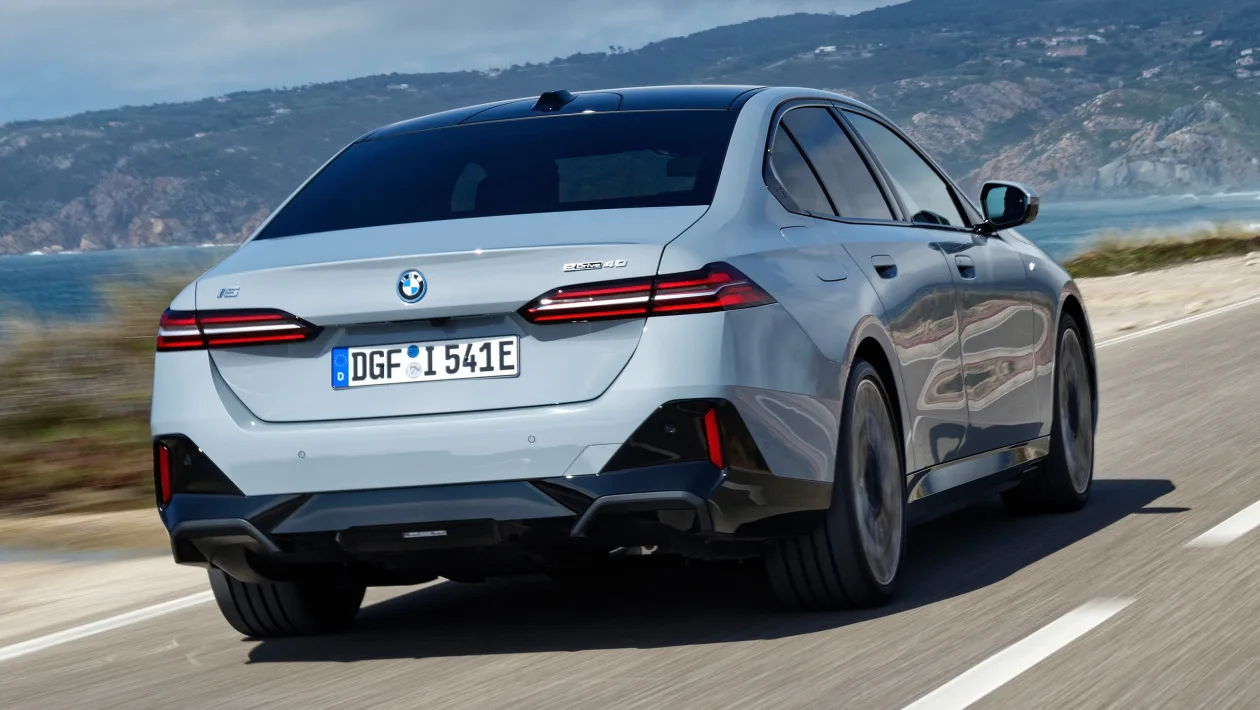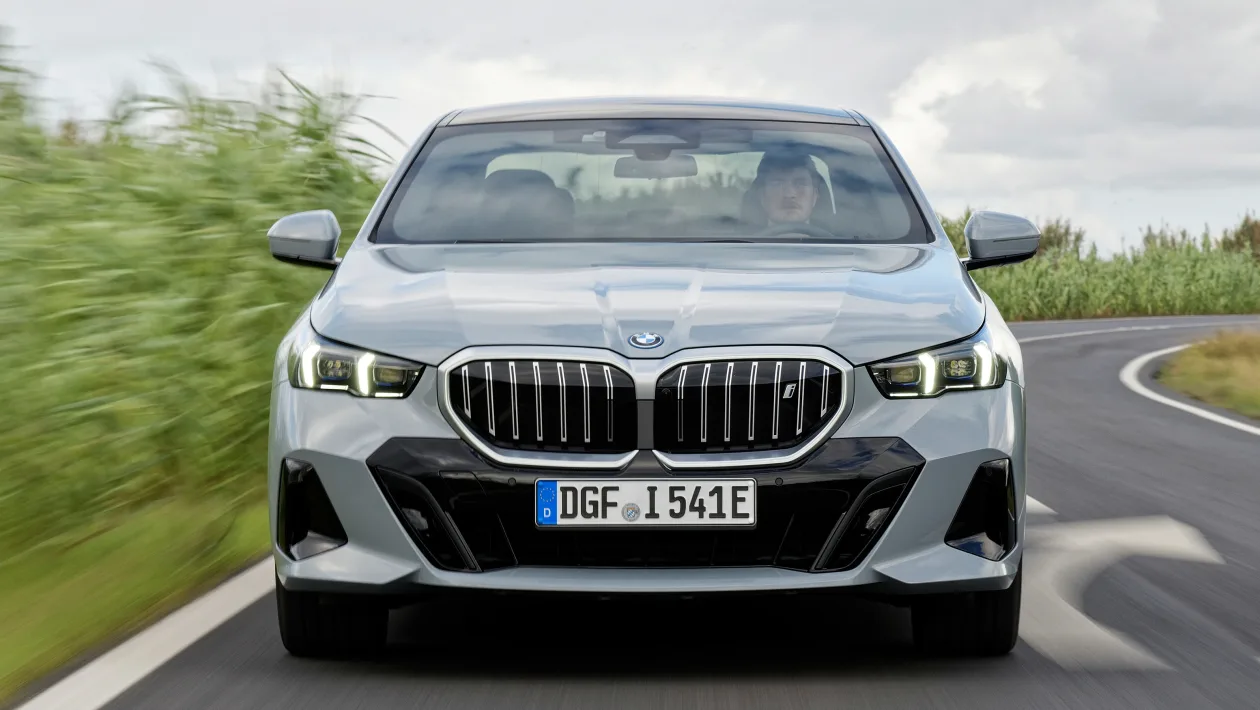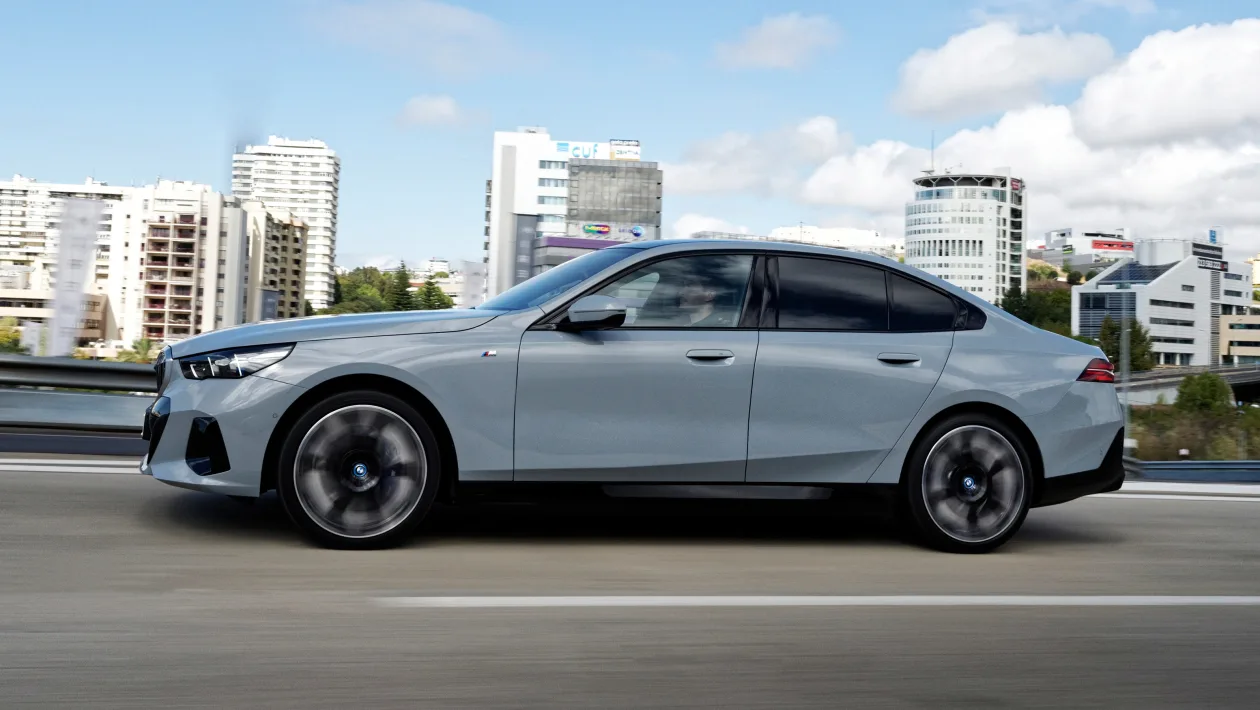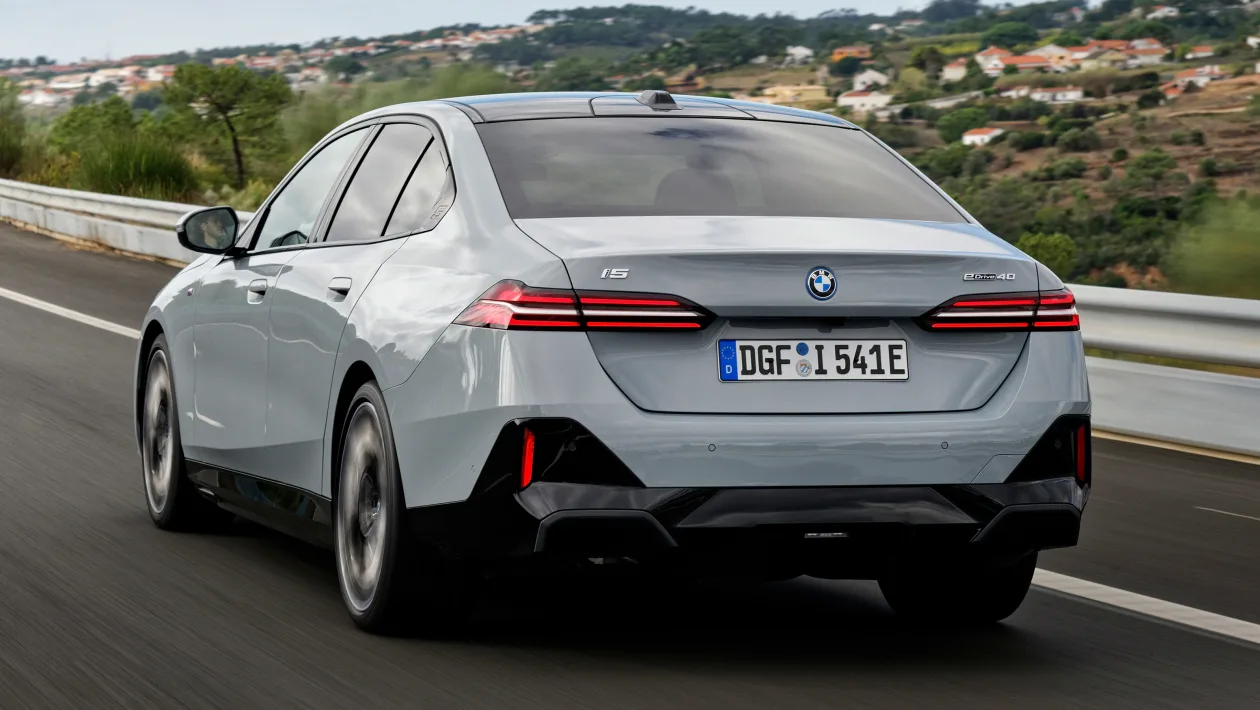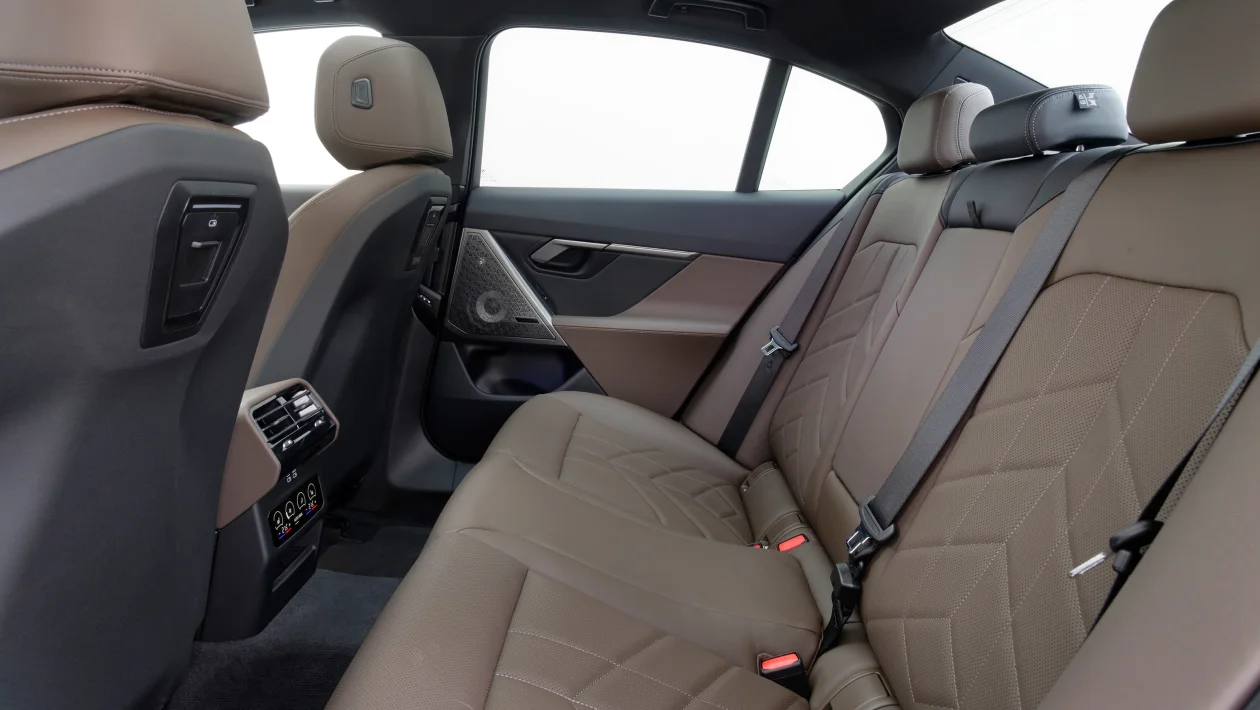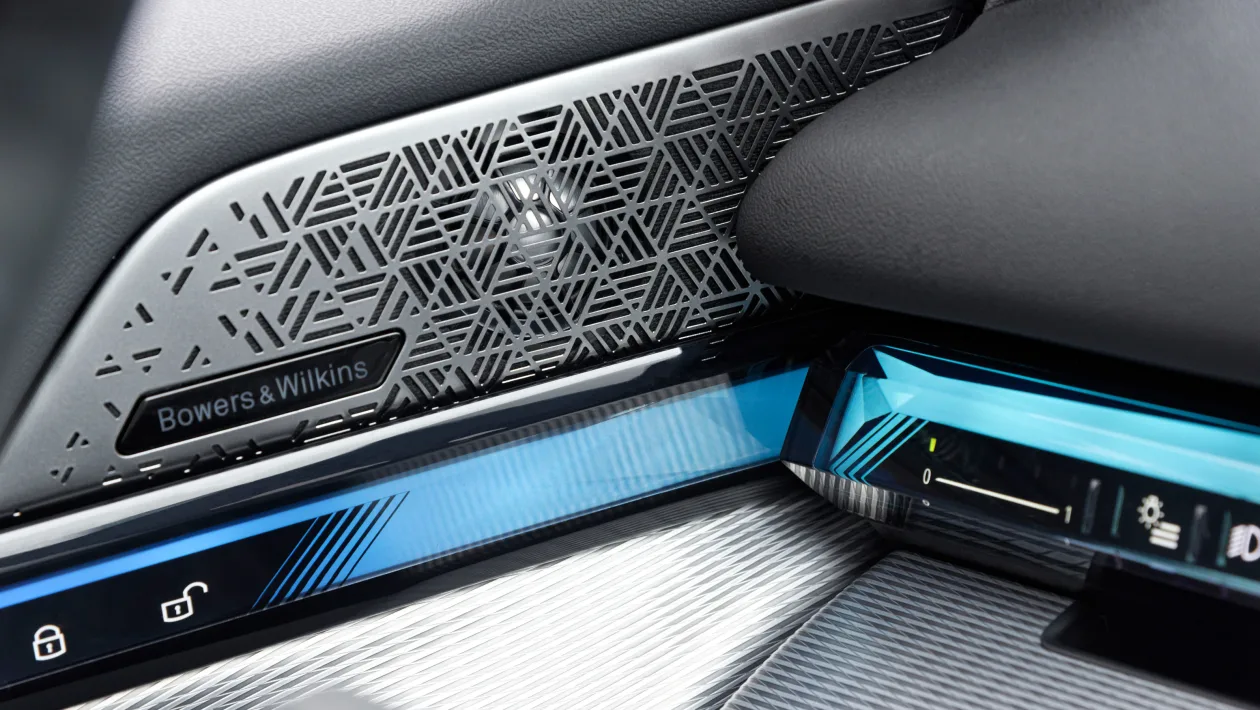The new 5 Series ushers in a landmark car: the company’s first electric exec sedan, and now we’ve driven it.
For a striking sign of the times, picture the pre-drive presentation of the new BMW i5, inside the cavernous underground garage of a slick high-rise in Lisbon.
Given the i5 is in essence the very first pure-electric BMW 5 Series, this is a history-making moment. BMW development chief Frank Weber has been on stage, reminiscing about the three-speed E12-gen 5 Series owned by the parents of his best friend at high school – and how the two teenagers wouldn’t hesitate to commandeer it when the opportunity arose.
At the Lisbon event we were privy to the upcoming i5 Touring, albeit with cameras confiscated at the door. As ever, the estate-specific bodywork is elegant, which you can’t say for the new 5 Series’ strangely pinched snout.
He then explains how, seven generations and half a century later, BMW is now “taking electrification to the business class” with this latest rendition of the 5 Series. Mercedes and Tesla may have something to say about that but it’s a reasonable statement. The latest 5 Series, codename G60, is the first of its lineage to extend to more than five metres (amazingly, it’s longer than the Bangle-era 7 Series) and from the get-go it spawns the i5, with up to 575km of claimed range.
Weber then gets into the details, which is what we’ve been waiting for, though nobody is expecting revelations of earth-shaking magnitude. We already know all G60 derivatives – from mild-hybrid 520i to electric i5 and, next year, 520kW-plus plug-in hybrid M5 – are based on a version of the CLAR platform that underpins the outgoing, and excellent, G30 5 Series.
For the new generation, the wheelbase has grown 20mm and the suspension hard points (there are wishbones up front, five links at the back, with air springs at the rear in the i5) have been tweaked but the core recipe is unchanged.
Weber now briefly justifies the homologous engineering approach. He says BMW won’t force customers into an unfamiliar model range simply because they want an EV.
‘Unlike Mercedes’, he may as well add, but resists. Instead, with BMW, whichever powertrain type best suits you – be it ICE, PHEV or EV – you can dress it in a 5 Series suit. The electric i5 is therefore as much a ‘proper’ 5 Series as any combustion model.
In Australia, we will get the single-motor 250kW eDrive40 tested here and the dual-motor 442kW M60 xDrive. And there’s the M5, of course.
And now, that sign of the times. Preamble over, we’re ready to learn how the world’s best-handling executive saloon has been made more rewarding and mechanically sophisticated, whatever the powertrain. But Weber is thinking differently.
He leads with the fact that BMW’s five-million-strong fleet of over-the-air-upgradable vehicles is the largest in the world. We then hear that navigation, telephony and entertainment are the most used functions in BMW’s cars (no mention of the steering wheel). We’re educated about the new OS 8.5 for the mesmerisingly crisp, curving infotainment display, and about BMW’s software joint venture, which is based in this very building and, along with another site in Porto, has capacity for 2000 engineers, all of them focused on UX and digital ‘premium mobility’ solutions. (Software aces conjuring chassis magic remain in Germany.)
On the presentation goes: a tidal wave of tech and software. YouTube. A Bundesliga app. Traffic light recognition. By the time we’ve heard about Highway Assistant, which allows for open-ended, hands-free cruising along a small but growing number of pre-mapped routes and lets the driver initiate a lane change by glancing at the corresponding wing mirror, there is uncertainty as to whether we’ll hear about mechanical matters at all…
Eventually on this journey, we get to the oily bits. But it’s only a slide or two. And not before we’ve been told that, from next year, i5 owners will be able to use their smartphones to control the car’s 12.9-inch display and, during charging, play Who Wants to be a Millionaire?
The message seems to be: we’re a tech company now, just one with an underlying, world-class car-making operation. To you and me, this seems an odd approach, but perhaps it’s necessary. Software is the new theatre of war for premium brands. We’re at the top of the S-curve for old-fashioned engineering, and ever-increasing data transmission rates are redefining in-car connectivity. Even Porsche is talking about the ‘software-defined vehicle’, so if you’re launching a business-class saloon in 2023, it needs to shimmer with tech.
Equally, if any BMW model needs to function as a chronological trapdoor back to more romantic times of uncomplicated driving satisfaction and three-box elegance, it’s the 5 Series. And therefore also this i5. So, when you’re not gaming, does it manage this?
The good news is it mostly does, with some caveats. A few hours on Portuguese roads showed that the i5 is comfortably sweeter to drive than the Mercedes EQE. It is heavy but it has balance and verve to spare. It handles like a traditional, longitudinally engined 5 Series, can be guided on the throttle, has generous straight-line performance and is easy to place on the road. On the inside, it’s less opulent than its main rival, perhaps, but it’s more spacious, and also more convincing in that feeling of deep-seated cabin quality that BMW currently does so well. Then there is the way this car ghosts from A to B.
Even on 21-inch alloy wheels, our i5 eDrive40 test car rides sublimely. In a blind test, you might even convince yourself you’re travelling in a full flagship in the mould of an S-Class or 7 Series.
With a slim, 84.4kWh battery spread out under the floor, this is an especially beefy 5 Series – at 2130kg it weighs 425kg more than the 520i – but engineers can use mass to calm primary ride and BMW hasn’t passed up the opportunity. Progress is blissfully unruffled at times – even if, as is BMW’s way, there isn’t much lavish, long-wave float, just levelness.
More confounding is secondary ride. One look at those absurd wheels and you think ‘oh dear’, but our i5 soaks up heat-crimped bitumen as though the Continental tyres have three times the depth of sidewall they do. It’s just superb. So it’s quite the wafter, this electric 5 Series, though note that our test car was fitted with the Adaptive Suspension Professional.
This is one of two optional, electronically variable suspensions, the other being M-flavoured with shorter springs. The standard-fit suspension is a passive set-up, which is again offered with shorter springs, for the agility-enhancing M Sport set-up. The thing to note is that the outgoing 5 Series doesn’t benefit from having a combo of large wheels and passive M Sport suspension, and the i5 will probably prove no different. City-centric drivers may also want one of the adaptive set-ups because this is the only way to have rear steering, which drops the i5’s turning circle almost to 3 Series’ scale.
The next bit is where personal taste comes into it. How do you like your 5 Series? How will you use it? The i5’s soporific manner informs its broader character. The 5 Series was always intended to function as a midpoint between the opulence of the BMW 7 Series and the dynamism of the 3 Series, but this new generation, at least in the i5 form tested here, is closer to its bigger sibling in spirit. Considerably closer, though there are other factors at play here.
The i5’s expansive but comfortingly high-sided vegan interior is very much a copy-paste job from the BMW i7, only with a little less flair and, in a nod to tradition, with a dash whose central portion is more angled towards the driver. Both cars also feature their own version of BMW’s ‘Interaction Bar’, whose faceted surface spans the width of the cabin. This bar is home to touch-sensitive controls for the ventilation. Migrating the rest of the climate controls onto the touchscreen is a questionable move but that screen can at least also be controlled with a rotary dial. On the whole, this set-up doesn’t frustrate.
Also nudging the new 5 Series and i5 towards 7 Series land is the fact that the bodyshell is, simply, pretty portly. Not only is the G60 97mm longer than the old G30, but it’s also 32mm wider and 36mm taller. Factor in the i5’s battery-augmented mass and you’re well in haute-limousine physical territory.
Only in the second row does the i5’s subordinate positioning to the i7 become readily apparent. Leg room is good but not plenteous. One limitation of spinning everything off the same platform is also found in the existence of a foot room-impinging transmission tunnel, which isn’t necessary for an electric car. As such, while you may not feel quite as urbane stepping out of the back of an Ioniq 5, Hyundai’s fine-riding, longer-wheelbased, more light and airy crossover might be just a little more relaxing on the move for rear passengers. The EQE is more claustrophobic than either.
Naturally, the 5 Series’ genetic shimmy towards the 7 Series also affects the driving experience, if subtly. All the jigsaw pieces are here: a gentle but undeniable rear-drive balance, the beautifully sped steering, the impressively natural feel of the regenerative braking response, the intuitiveness of the accelerator response, which is sharp without being at all spiky. Body control is also how you would want it, being neat and crisp but also free enough to convey road speed and a sense of flow. The i5 is always superbly composed.
Some of that is down to the fact that BMW hasn’t just slid a battery pack into the regular 5 Series chassis. The EV gets a stiffening panel for the front subframe and a large, trough-shaped plate that connects the front struts to the bulkhead. The real work is at the back, however. Here, the subframe is fixed to the floorpan with additional torsion and compression struts, in an effort to extend rearwards the exceptional stiffness that the battery pack affords the monocoque.
BMW engineers will quietly tell you this is a key strength relative to the EQE.
And yet from the driver’s perspective, there’s still a notable sense of detachment. The car is so large that it never shrinks around you. All that mass needs managing – at times by you the driver and always by the complex ecosystem of electronic tuning that links the behaviour of the active anti-roll bars, the rear-wheel steering, the brake-based torque vectoring and the by-the-millisecond damping rates.
There’s clearly a hell of a lot going on behind the scenes. There is also the steering, whose assistance is necessarily increased in the face of so much kerb weight and loses some transparency in the process. Its feedback feels synthetic.
Still, personal taste. Want a cut-price i7 that’s easier to live with, easier on the eyes, and more engaging to drive? Step this way. It’s unlikely you will be disappointed by the i5. But want some of that old-school 5 Series character, only in electric form? There’s a chance you might find this car altogether too stately.
Price: i5 eDrive40 – $155,900 before on-road costs
Power: 250kW/430Nm
Tested: Lisbon, Portugal
On-sale in Australia: Q4 2023
And what about the i5 i5 M60?
BMW has yet to reveal a bona fide electric M car and is instead leveraging its M Performance sub-brand to inject EVs with extra dynamism and speed.
It’s having reasonable success too. Last year, the i4 M50 was the best-selling M car globally, according to M division chief Frank van Meel. BMW also now has the 485kW i7 M70.
The i5 M60 xDrive is the third electric M Performance derivative and delivers 442kW, along with 0-100km/hin 3.8sec. It sits 8mm lower than the i5 eDrive40, though this suspension set-up is available on the regular i5 as an option, as are the wheels and much of the aesthetic elements. In truth, there is not much that’s bespoke about the M60, and despite that huge power output, it’s not especially ferocious in character.
I quickly warmed to it, though. Out in Portugal, the M60 was every bit as languidly slick as the eDrive40 at a cruise but on interesting roads had an underlying fizz and composure the basic car doesn’t. It’s a truly satisfying steer, even if you take performance out of the equation.




